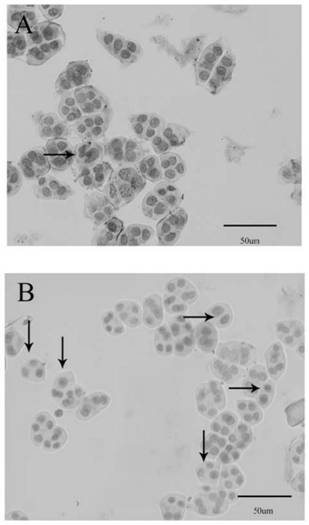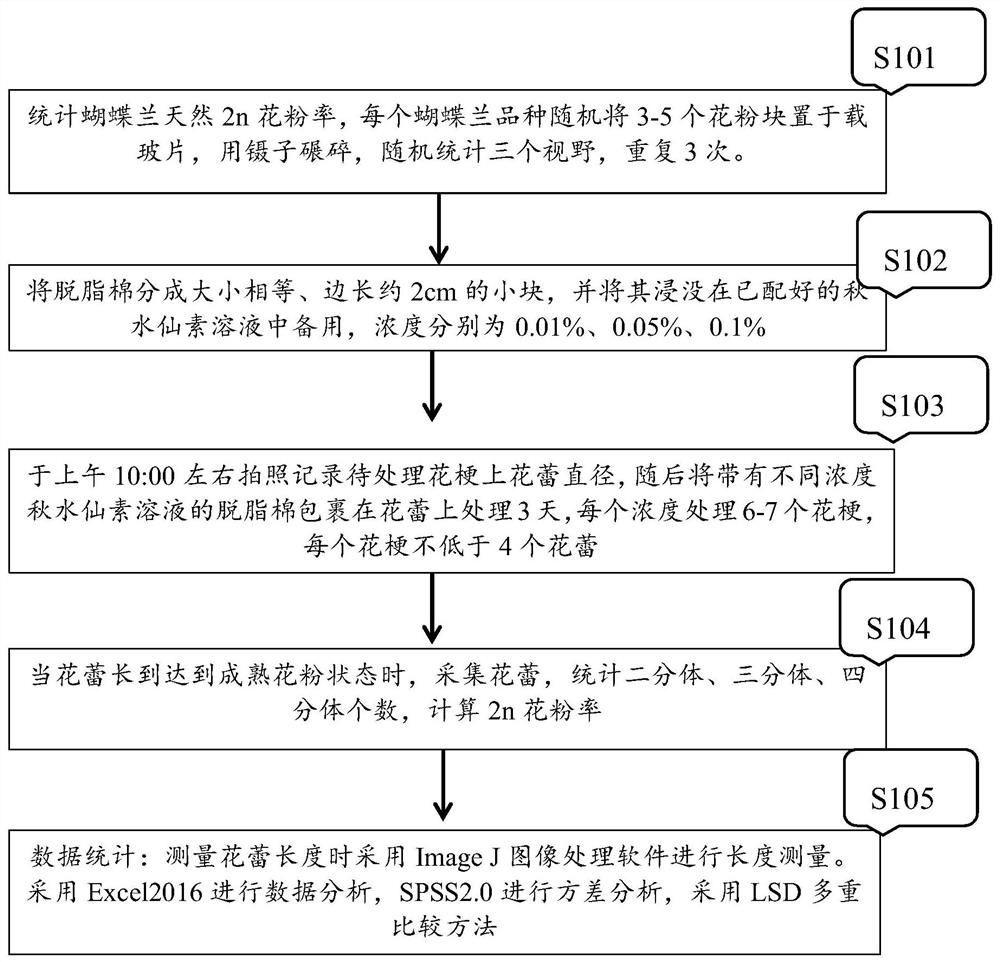Opportunity and method for inducing 2n pollen of phalaenopsis amabilis
A technology for phalaenopsis and pollen, applied in the field of polyploid breeding, can solve the problems of complex ploidy and genetic background, unable to obtain ideal 2n pollen induction rate, and increasing difficulty in 2n pollen induction research.
- Summary
- Abstract
- Description
- Claims
- Application Information
AI Technical Summary
Problems solved by technology
Method used
Image
Examples
Embodiment 1
[0085] Embodiment 1: Natural 2n pollen yield statistics
[0086] After the Phalaenopsis pollen matures, it exists in the form of tetrads. Observe and record the number of dyads, triads, and tetrads in the mature pollen of Phalaenopsis, and calculate the natural 2n pollen rate. Each Phalaenopsis variety randomly divides 3- 5 pollen blocks were placed on a glass slide, crushed with tweezers, and three visual fields were randomly counted, repeated 3 times. 2n pollen ratio=(2Dy+Tr) / (2Dy+3Tr+4Te), where Dy is the number of dyads, Tr is the number of triads, and Te is the number of tetrads.
[0087] It was found that, except Mantianhong ( image 3 E) Except that normal pollen cannot be produced due to synaptonemal disorder, dyads and triads have been observed in the other five species of Phalaenopsis ( image 3 A-D, image 3 F). The statistics of the natural 2n pollen rates of five species of Phalaenopsis are shown in Table 1. It is found that the natural 2n pollen rates are sig...
Embodiment 2
[0092] Example 2: Using colchicine to induce 2n pollen
[0093] Divide the absorbent cotton into small pieces of equal size and side length about 2 cm, and immerse them in the prepared colchicine solution for later use, the concentrations are 0.01%, 0.05%, and 0.1%, respectively. Take photos at around 10:00 in the morning to record the diameter of the flower buds on the flower stalks to be treated, and then wrap the absorbent cotton with different concentrations of colchicine solution on the flower buds for 3 days, and treat 6-7 flower stalks for each concentration, and each flower stalk is not lower In four flower buds, the effects of meiosis stage and colchicine concentration on the 2n pollen induction rate of Phalaenopsis were mainly investigated. When the buds reached the mature pollen state, the buds were collected, and the numbers of dyads, triads and tetrads were counted in the same manner as in Example 1, and the 2n pollen rate was calculated.
[0094] The flower buds...
Embodiment 3
[0105] Embodiment 3: establish the corresponding relationship between Phalaenopsis flower bud diameter and pollen meiosis stage
[0106] From the end of May to the end of August 2020, randomly select three smaller flower buds of each variety to observe the growth changes of the flower buds. At around 10:00 in the morning, take pictures to record the diameter of the flower buds, and record once a day until the flower buds bloom.
[0107] At the same time, 6 kinds of Phalaenopsis flower buds of different sizes were picked at 10:00-14:00 on a sunny day (10-20 flower buds of different sizes were picked for each kind, repeated 3 times), and the diameter of the flower buds was recorded by taking pictures, and put into Carnot’s fixative ( Absolute ethanol: glacial acetic acid = 3:1) fixed for 12-24h, then transferred to 70% ethanol, and stored in a refrigerator at 4°C for later use. After washing with distilled water for 2-3 times, place the anthers on the glass slide, mash them with t...
PUM
 Login to View More
Login to View More Abstract
Description
Claims
Application Information
 Login to View More
Login to View More - R&D
- Intellectual Property
- Life Sciences
- Materials
- Tech Scout
- Unparalleled Data Quality
- Higher Quality Content
- 60% Fewer Hallucinations
Browse by: Latest US Patents, China's latest patents, Technical Efficacy Thesaurus, Application Domain, Technology Topic, Popular Technical Reports.
© 2025 PatSnap. All rights reserved.Legal|Privacy policy|Modern Slavery Act Transparency Statement|Sitemap|About US| Contact US: help@patsnap.com



